Rice farming has long been a cornerstone of global agriculture, feeding billions of people every day. However, it is also a significant source of methane emissions, a greenhouse gas nearly 30 times more potent than carbon dioxide over a 100 year period.
Traditional rice cultivation involves flooded paddies, creating anaerobic conditions that promote methane production by microbes in the soil. As climate change accelerates, reducing these emissions has become critical.
Enter a New York based AI startup helping rice farmers a company that is merging technology and grassroots farming knowledge to address one of agriculture’s most pressing environmental challenges.
Methane emissions from rice paddies contribute significantly to global warming. The problem is especially pronounced in countries such as India, Vietnam, and Thailand, where rice farming dominates rural livelihoods.
For years, attempts to reduce emissions have been limited by lack of data, technology, and farmer engagement. Many approaches were too generalized or costly for smallholder farmers, leaving a gap that innovative technology can fill.
This is where the AI startup helping rice farmers comes in. Unlike traditional interventions, this company uses artificial intelligence and satellite data to measure methane emissions with unprecedented accuracy. By doing so, they empower farmers to adopt climate friendly practices tailored to their specific fields.
AI Powered Monitoring of Rice Fields
The startup has developed a proprietary digital Monitoring, Reporting, and Verification (dMRV) system. This system combines satellite imagery, soil sensors, and AI algorithms to calculate methane emissions from individual paddies.
This approach allows the company to quantify emissions on a large scale while also identifying the most effective interventions for each farm. Dr. Nathan Torbick, co-founder of the startup, explains. Each farm is different.
Our AI system ensures that farmers receive actionable insights to maximize yield while minimizing emissions. Farmers receive personalized recommendations, such as alternate wetting and drying of paddies, which reduces methane release without compromising rice production.
The technology also allows for real time tracking of improvements, making it possible for farmers to see the tangible impact of their climate friendly efforts, Technology alone cannot solve the problem.
The AI startup helping rice farmers complements its cutting edge tools with hands on training. Field officers work directly with farmers to demonstrate sustainable practices, from efficient water management to soil health improvement techniques.
In India, the startup partnered with The Nature Conservancy’s PRANA program to train over 650,000 farmers by 2025. Farmers who initially hesitated to change their methods gradually embraced new practices when they saw measurable reductions in methane emissions and improvements in crop yields.
A group of farmers practicing alternate wetting and drying reported a 20% reduction in water use and a notable decrease in methane emissions. Their rice yield also increased slightly, showing that sustainability and productivity can go hand in hand.
Economic Incentives through Carbon Credits
One of the most innovative aspects of the AI startup helping rice farmers is the integration of carbon markets. Farmers who reduce methane emissions generate verified carbon credits, which can be sold to corporations seeking to offset their emissions.
This model provides an additional revenue stream for farmers. On average, participants have seen up to a 15% increase in income, combining higher yields with income from carbon credits. This creates a sustainable incentive for farmers to continue adopting climate friendly practices.
Climate scientists and agricultural economists are optimistic about this approach. Professor Linda Chen, an expert in sustainable agriculture, notes. By leveraging AI and directly involving farmers, this startup is addressing both technological and social barriers to emission reduction.
It is a scalable model that could transform rice farming globally. The startup’s work demonstrates that high tech solutions can coexist with traditional farming methods when implemented thoughtfully.
Although the company started in India, its model is designed for global expansion. By offering its AI powered monitoring system as a Softwarebas a Service (SaaS), the startup can reach rice growing regions in Southeast Asia, Africa, and Latin America.
In the Philippines, pilot programs with smallholder farmers using the AI driven system showed an average 25% reduction in methane emissions per hectare. Farmers also reported improved soil quality.
Which could lead to long term benefits beyond emission reductions. The combination of AI monitoring, farmer training, and financial incentives creates a holistic approach to climate smart agriculture.
Personal Experiences from Farmers
Many farmers initially viewed the program with skepticism. Rajesh Kumar, a rice farmer in Punjab, shared his experience. At first, I thought this AI system was too complicated.
But after using the recommendations for one season, I saw my water costs decrease and my rice yield improve. Now I encourage my neighbors to join. Such testimonials highlight the effectiveness of combining technology with direct human engagement.
The success of this AI startup helping rice farmers lies in three key factors. Measuring methane at the field level enables targeted interventions.
Hands on training ensures adoption of sustainable practices. Carbon credits provide financial motivation to maintain climate friendly methods.
Together, these elements create a model that is not only environmentally effective but also socially and economically sustainable.
Rice farming is an essential part of the global food system but also a significant contributor to climate change. The New York based AI startup helping rice farmers shows that technology,
When combined with farmer engagement and financial incentives, can reduce methane emissions without compromising livelihoods.
By empowering farmers to adopt sustainable practices, the startup is paving the way for climate smart agriculture that benefits both the environment and rural communities.
This model demonstrates that the intersection of AI, environmental stewardship, and economic opportunity can create lasting change, offering a blueprint for global agriculture in the era of climate change.

